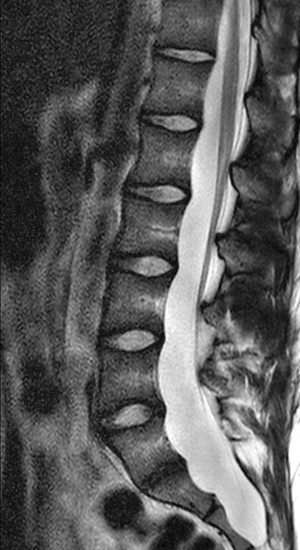A tough, dense membrane that completes the anatomy of protection around our spinal cord, the 'dura' can become much thinner and stretchier in Marfan syndrome. This can lead to dural ectasia and sometimes translates into pain ....
Dural Ectasia is enlargement of the neural canal anywhere along the spinal column. The dura (envelope) surrounding the spinal cord enlarges, especially in the lower lumbosacral region where cerebrospinal fluid pressure is greatest.
It can be the first clue that prompts a doctor to carry out further investigations and consider a diagnosis of MFS.

Symptoms
Dural ectasia often doesn’t cause any symptoms. However, if present, the symptoms include:
- Low back pain
- Headache
- Radicular pain in the legs or buttocks (nerve pain radiating from the back)
- Loss of sensation above and below the affected area (occasional)
- Rectal pain/genital pain
Symptoms can be aggravated by lying face downward and are relieved by lying on the back. Pain can also be postural (worse when standing up) as the cerebrospinal fluid will pool in the dilated area.
Diagnosis
Magnetic resonance imaging (MRI) is usually used to diagnose DE as it is better at imaging the dural sac (Pollock et al, 2021) than other imaging techniques like computed tomography (CT) although these can be used if MRI is contraindicated.
Treatment
Most of the treatment for DE is conservative and involves pain medication and physiotherapy.
Severe postural headaches may be due to a cerebrospinal fluid leak; a tear can occur in the dura due to the weakened tissue. In these cases, an epidural blood patch may be considered (injection of a small volume of the patient’s own blood into the epidural space with the aim of creating a blood clot to seal the tear).
Spinal Anaesthesia (including epidural during labour and delivery)
This needs to be carefully considered for individuals with Marfan syndrome. There are case reports in the literature that point to problems with the effectiveness of spinal anaesthesia in Marfan syndrome, which are thought to be due to DE and the resulting increased volume of lumbar cerebrospinal fluid.
Anaesthetic review prior to surgery is important for cases in which spinal anaesthesia may be used.









